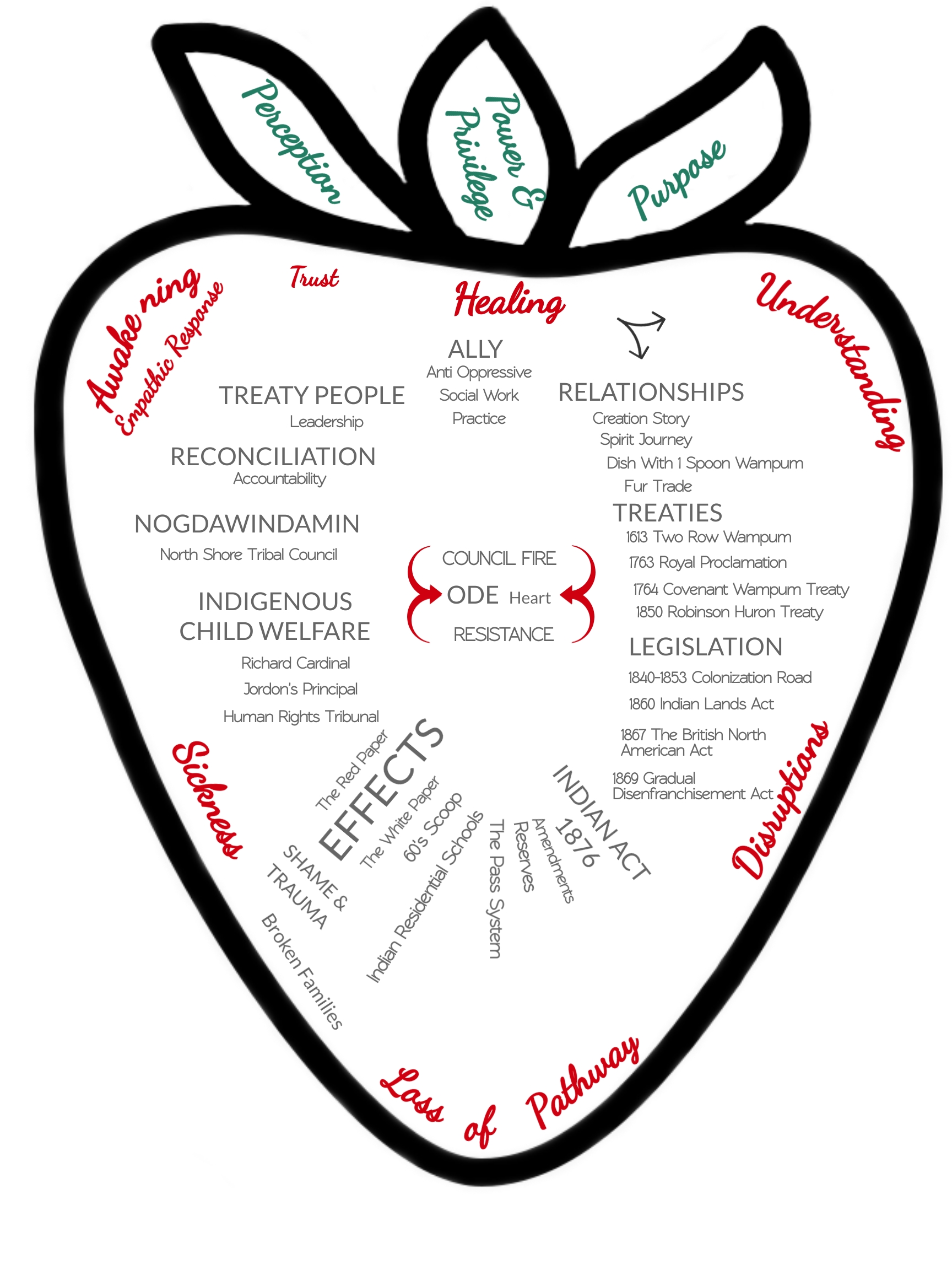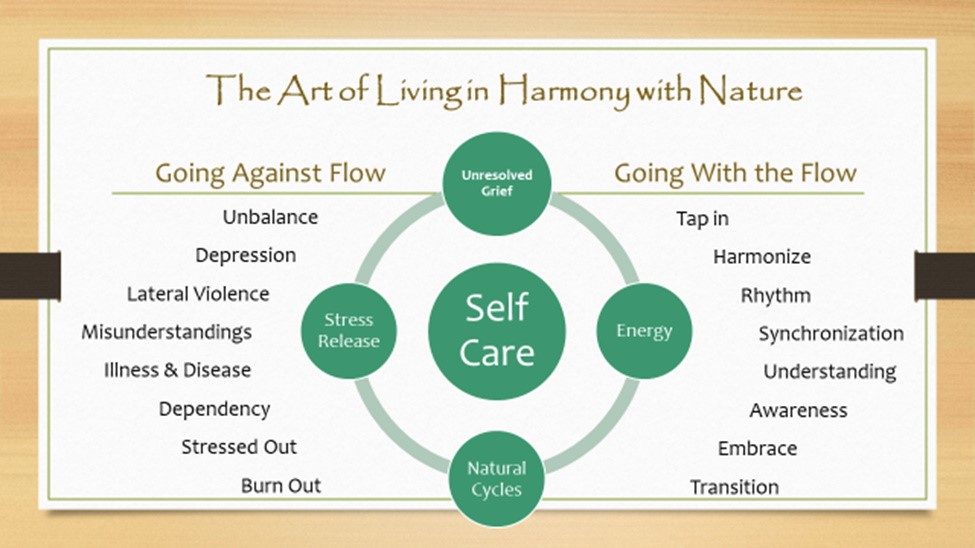9
Learning Objectives
A healing journey is a very personal experience and has large implications to a person’s wellness and state of being. This bundle explores this concept and encourages self exploration.
- Defining the term healing journey;
- Defining shame, exploring how this has effects on emotion and behaviours; and
- Exploring personal healing journey.
We are all sacred beings
Another way of looking at the Seven Grandfather Teachings, is through the Eagle Feather Teachings. Acknowledging the positive also requires acknowledging the other side of that spectrum, and the balance in it all.
On the feather image, the center lists the Seven Grandfather Teachings, on the right are some human behaviours that coincide with each grandfather teaching. The list on the left represents Human Nature in context to brain development.
Expanding on the concept of what the human brain needs for healthy development, taking the Spirit Journey further.

| Human Nature
Gabor Maté |
7 Grandfather Teachings | Human Behaviours
Mike Bisson |
|---|---|---|
| Attachment
Bonding with caregiver Family Systems |
Love
Unconditional |
Hate (conditional love)
Antagonistic/Guard up |
| Compassion
To have empathy |
Respect
To go easy on |
Arrogance
I am better than you |
| Perspective
How we see the world |
Truth
Speaking the truth |
Lies
The Canadian Narrative |
| Authenticity
Ability to be true self |
Courage
Has strong heart |
Fear
Worry & Anxiety |
| Belonging
Family |
Humility
To think lowly of one’s self |
Ego
Healthy vs Unhealthy |
| Societal Stress
Dependency |
Honesty
Living in a proper way |
Greed
Infatuation & Desire |
| Connection
Self Concept |
Wisdom
To have vision |
Falsehood
Self Concept – Shame |
We live in a country that fosters shame with lies, secrecy and judgement is the foundation. When working with indigenous communities, this concept is paramount to adjusting professional approaches. Understanding Shame and understanding emotional intelligence is the cornerstone to anti oppressive approaches.
How do you define a healing Journey?
Facilitator Tip:
- An introduction to a healing journey, the intention is to explain what this is, and have participants reflect on where they are in theirs.
- Facilitators are encouraged to share a little piece of their personal story that is appropriate (keeping time conscious).
- The depth of this module will depend on the facilitator’s ability and knowledge.
Defining a Healing Journey
- Some points are listed below to go over with the group.
- This original definition will be revisited at end of the day when participants will be asked to reflect on if the meaning of a healing journey changed.
- Ask the group to define their own meaning of what “a Healing Journey” means to them.
You can open up for participants to share their answers.
A healing journey is:
- It’s personal, everyone has their own way to “define it”;
- A person’s healing journey is unique and individual;
- It is deep interpersonal learning and embracing our own vulnerability, this is moving from our head to our heart. This is the hardest journey;
- Nurturing our little girl/little boy;
- Some people may stay stagnant, get stuck, or veer off the path. This is apart of their journey; The Stages of Change Model, has a stage of relapse. This could be a person’s shame and distractions that they battle with while changing old patterns to new;
- Learning to communicate with the spirits/higher power and connect with one’s own spirituality;
- Understanding of how to let their spirit expresses itself;
- Learning, awareness, understanding and mastering our gifts;
- Addressing personal suffering; acknowledging and becoming aware of shame triggers to be able to process (Recognize, Awareness, Investigate and Nurture). This is taking ownership of the unhealthy shame we carry;
- Having to “show up” and be fully present to do the “work”, this is the hardest part;
- It’s never done, but “processing” gets easier with practice and doing the work.
 Example: The Strawberry Pathway, the double arrow at top indicates that once a person becomes informed of the intergenerational wounding and historical trauma’s, they begin to relate with their personal experiences; then it is moving through the information again from a different space & place of knowing and understanding. It is bringing the experience “from the head to the heart.”
Example: The Strawberry Pathway, the double arrow at top indicates that once a person becomes informed of the intergenerational wounding and historical trauma’s, they begin to relate with their personal experiences; then it is moving through the information again from a different space & place of knowing and understanding. It is bringing the experience “from the head to the heart.”
Healing on a Healing Journey,
Mapping The Healing Journey: The final report of a First Nation Research Project on Healing in Canadian Aboriginal Communities.
https://www.publicsafety.gc.ca/cnt/rsrcs/pblctns/mppng-hlng/index-en.aspx#healing5
- A Healing Journey is an individual process and can be within a community context, which occurs over long term possibly several decades.
- Healing cannot be confined to issues such as addictions, abuse or violence.
- Healing Journey focuses on well-being rather than on sickness.
- Includes the process of cultural recovery
- “Healing as recovery” essentially involves moving away from the pain and suffering”
- “Healing as wellness” involves moving towards and maintaining healthy patterns of life”
- It took generations for many communities to internalize the pain and trauma they now carry and it may take generations to move past them.
Healing is a developmental process aimed at achieving balance within oneself, within human relationships and between human beings and the natural and spiritual worlds. It has to do with choosing to live in harmony with the basic values and teachings that are at the core of all Aboriginal (as well as other) cultures. “Healing” actually describes a wide range of initiatives, impulses and efforts happening at the levels of the individual, the family, the community, organizations and institutions and the nation.
Healing as Decolonization.
At this point in history the healing journey has a lot to do with overcoming the legacy of dependency and dysfunction that are the result of decades of colonization, missionization and residential schools. The term “healing” refers to restoring human and community integrity and well-being that were destroyed by the aftermath of such historical trauma. It is certainly not confined to the restoration of mental health and the ending of dysfunctional behaviors such as abuse, addictions and violence, though it does, of course, include these things. Those working on the front lines of it sometimes describe community healing as “decolonization therapy”.
Facilitator Tip:
- A great place to share a personal healing journey story.
- A place to invite guest from one of the 7 First Nations to share a story.
Art of Living in Harmony
The art of living in harmony diagram, illustrates the difference between:
“Going with the flow” – this means there is little resistance by paying attention, listening, acknowledging and acceptance of events that happen in our lives.
“Going against the flow” – this means there is a lot of resistance, and there is more distractions, we are not listening and there is no acknowledgement and total denial to the events that are happening in our lives.

Facilitator Tip:
- Based on facilitators experience, good opportunity to share an experience to illustrate this.
- Example, when on the path that is meant for me it feels like I don’t need to “make things happen”, it all happens on its own. When I veer off that path, I find I have roadblock after roadblock, and I am spinning my wheels and not going anywhere. This is when my family will smoke the pipe and ask for direction.
Self Reflection
What stops us from “going with the flow” to “going against the flow?”
This answer is multi-layered, but the root comes back to SHAME.
The Anatomy of Shame
Shame: the intensely painful feeling or experience of believing that we are flawed and therefore unworthy of love and belonging – something we’ve experienced, done, or failed to do makes us unworthy of connection. Brené Brown – Dare to Lead.
There is healthy shame, which is guilt, and this is focusing on the behaviours, “I did something bad.” This has a strong relation to a person’s empathy building skills and the ability to have an understanding from another person’s perspective.
Unhealthy shame focuses on self, “I am bad, I am unworthy, I do not deserve.” There is a direct connection of colonization and the unhealthy shame Indigenous people carry that is deep rooted in their unconscious. The effects of shame have a strong relationship with addiction, depression, violence, aggression, bulling, suicide, and eating disorders to name a few.
The shame becomes our story, which effects every single relationship in our lives past, present and future. Shame is the reason we get defensive, we hear what we want to hear, we get caught up in another person’s “story” and make it personal about ourselves. We feel deep down that we are not enough, so we move into a place of unauthenticity (our fake selves) so that we feel accepted.
Shame grows exponentially in: 1) secrecy, 2) silence and 3) Judgement.

We are now coming out of an era where these were the main rules to live by in a colonized Canada.
“Remember empathy is the most powerful, connecting and trust building tool that we have, and it’s the antidote to shame.
If you put shame in a petri dish and cover it with judgment, silence and secrecy, you’ve created a perfect environment for shame to grow until it makes its way into every nook & cranny of your life.
If on the other hand, you put shame in a petri dish & douse it with empathy. Shame loses it’s power and begins to wither.” Brené Brown
Facilitator Tip:
Ask participants to give some examples that shows we are moving out of the secrecy, silence and judgement. Allow time for discussion.
Highlights: Truth and Reconciliation Commission, 60’s Scoop Class Action, Land Claims, The Caring Society’s work.
Or
Ask participants where shame shows up in their own life?
Can shame be seen in community members? Are there certain situations or scenarios where it shows up more intensely?
Key Takeaways
- Defining what a healing journey is, identifying elements of personal healing journey.
- Understanding personal shame and how that effects decisions and relationships. Identifying personal areas where shame is carried.
Media Attributions
- Feather Teachings with GFT
- Genogram chart of symbols
- The Art of Living in Harmony
- 3 elements of shame